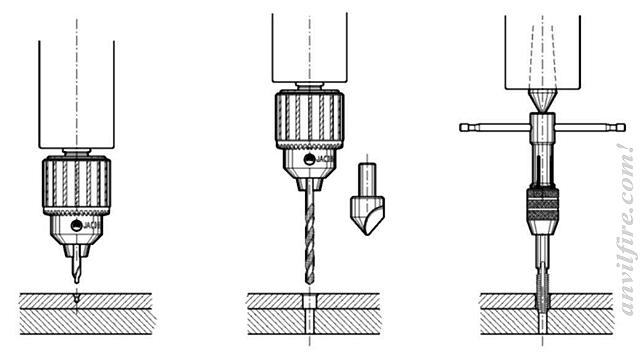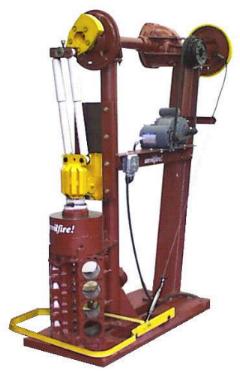Building from junk is an art, a philosophy and a lifestyle.
It also takes imagination, knowledge of mechanics and a love of machinery.
Some engineering skills do not hurt but a gut feeling for the strength of parts and materials can go a long way.
Knowledge of how many machines work is a junk builders most important tool and is usually learned from an early age taking things apart.
The change from mechanical clocks and watches to digital,
and to autos with electronic controls that are too high tech for a backyard mechanic is adversely effecting the educational climate for potential junk builders.
Parents, PLEASE give your children real tools and things to take apart!
The Erector Set was probably the most important educational toy of the early 20th Century.
MANY THINGS in these articles are written with tongue in cheek and should be taken with a sense of humor as well as tempered with common sense. Humor IS part of the philosophy.
Facts:
The junk builder uses steel for everything possible because it can be efficiently and cheaply arc welded together.
Plans are something a foreign enemy makes.
"Blue Prints" are material for a woman's dress or a wall paper pattern.
The strict junk builder rarely has a happy marriage because women make plans and hate junk.
Women are rarely junk yard builders. Its against their nature.
Yes, this is sexist and not PC, but its the truth.
Techniques
See
Junk Yard Construction Rules as an overall guide.
In order of use in the junk yard build.
- Alignment
- Method 1. Hold in place (by hand if possible, use Vise-Grips or clamp if necessary) then weld.
- Method 2. Clamp or tack weld together. Drill, or drill and tap in assembly
(see threaded holes below).
- Method 3. Set in place or clamp. Transfer punch, drill as needed.
- Method 4. Last Resort - Measure and layout to a detail plan.
- Assembling Components
- Method 1. Arc weld SMAW (stick)
- Method 2. Arc weld MIG
- Method 3. Arc weld TIG
- Method 4. Torch holes and rivet or bolt.
- Method 5. Drill and Bolt (for important removable or unweldable components only)
- Cutting Steel
- See Layout below
- Method 1. Mark with talc chalk. Torch and grind as necessary.
- Method 2. Mark with chalk or pencil. Use abrasive chop saw.
- Method 3. Mark with pencil or scriber. Cut on saw.
- Disassembly (Rusted Nuts/Bolts)
- Method 1. Use impact wrench if available (fast - efficient)
- Method 2. Heat nut with torch until red. Apply penetrating oil as it cools. Remove with wrench.
- Method 3a. Cut off with torch.
- Method 3b. Rounded Bolt in tapped hole - weld oversize nut to held of bolt. Remove with wrench.
- Method 4. Drill out, use "Easy-Out" bolt extractor.
- Making Round Holes
- Method 1. Find a part with the right hole and weld it on.
- Method 2. Torch and grind with a die grinder.
- Method 3. Last resort - drill on drill press or bore on lathe.
- Layout
- Method 1. Use anything straight to make a line - mark with talc chalk.
- Method 2. Make curves using a round item for template (bucket, can) and mark with chalk.
- Method 3. Use tape measure and or carpenter's square and mark with chalk.
- Method 4. Use above methods and mark with pencil (silver or black) if sawing or drilling.
- Method 5. Last Resort for machined parts only. Use precision scale, dividers, layout blue and scribe.
- Threaded Holes
- Method 1: Reevaluate and use through holes with nuts and bolts.
- Method 2: Use parts or pieces with threaded holes, weld together if necessary.
- Method 3: Install bolt and nut or clamp nut to part, weld nut into place - "heavy" or square or oversize nuts work best.
- Method 4: Last Resort - drill and tap as necessary. Do so in assembly so that precise measurements are not necessary.





Knowledge of how many machines work is a junk builders most important tool and is usually learned from an early age taking things apart. The change from mechanical clocks and watches to digital, and to autos with electronic controls that are too high tech for a backyard mechanic is adversely effecting the educational climate for potential junk builders. Parents, PLEASE give your children real tools and things to take apart! The Erector Set was probably the most important educational toy of the early 20th Century.
MANY THINGS in these articles are written with tongue in cheek and should be taken with a sense of humor as well as tempered with common sense. Humor IS part of the philosophy.
Facts:
The junk builder uses steel for everything possible because it can be efficiently and cheaply arc welded together.Plans are something a foreign enemy makes.
"Blue Prints" are material for a woman's dress or a wall paper pattern.
The strict junk builder rarely has a happy marriage because women make plans and hate junk.
Women are rarely junk yard builders. Its against their nature. Yes, this is sexist and not PC, but its the truth.
Techniques
See Junk Yard Construction Rules as an overall guide.In order of use in the junk yard build.
(see threaded holes below).